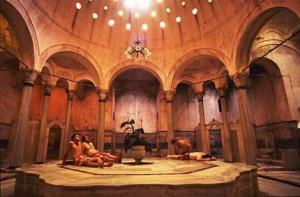 Under the freeway in north Seattle may seem like an unlikely place for a spa, but then again, Little Red Day Spa is not your ordinary establishment. Artist Jeff Hengst shares his personal studio with the community by opening the space as a spa for private, reservation session and—a handful of times a month—for public drop-ins. His oil paintings of human forms and other organic shapes line the walls of this creative cave, and telltale signs of inspiration can be seen on the hardwood floor. Though the room is large and with high ceilings the space still feels intimate and it was only during my orientation tour that the spaness of the space became evident.
Under the freeway in north Seattle may seem like an unlikely place for a spa, but then again, Little Red Day Spa is not your ordinary establishment. Artist Jeff Hengst shares his personal studio with the community by opening the space as a spa for private, reservation session and—a handful of times a month—for public drop-ins. His oil paintings of human forms and other organic shapes line the walls of this creative cave, and telltale signs of inspiration can be seen on the hardwood floor. Though the room is large and with high ceilings the space still feels intimate and it was only during my orientation tour that the spaness of the space became evident.
The woman who gave me the tour was hosting the evening. She was friendly and helpful, yet she warned me repeatedly and in no uncertain terms that sexual behavior, or even “sexual energy”, were completely unacceptable at the spa. After the third direct statement I was starting to feel a bit uncomfortable, especially as I had brought my longest and most loyal spa-going companion—my mother—with whom I was beginning to exchange dubious looks. We were hoping for a relaxing evening of chatting and pampering, unfortunately for us, on this evening, it was not to be.
We went for one of the Ladies Night drop-in evenings, which, like all drop in sessions male or female, is clothing optional. There was a free-spirited, bohemian vibe to the event that intensified as more people showed up. Everyone enjoyed taking the time to choose a unique bathrobe from the large wardrobe. Then with the wine and other refreshments they had brought, draped themselves across couches or chairs and soaked in the hot tub.
My mother and I were both fully aware that “clothing optional” actually means, “clothing frowned upon.” We have gone to many spas together and some of those have been “skin only”. But the fact that a “please sit on your towel” policy did not seem to apply to the furnishings, here, and the fact that hostess felt the need to make numerous and pointed reminders about not being sexually active in the spa, made us a tad uncomfortable. We made a snap decision to cover up and became the proverbial lepers of the evening. We also obviously flustered our hostess, who came over to say that she supported our decision to wear bathing suits, but we would probably be more comfortable if we took them off. I know she was trying to be kind, but it ended up making the whole thing turn slightly nightmarish, especially as the place was filling up with naked women who were gawking at our covered bodies.
 Determined to get our money’s worth without dropping our vestments, we soaked for a few minutes in the disappointingly tepid tub before moving on to the redeeming part of the evening: a self-administered, clay body-mask and “salt glow”. A large blanket was spread on the floor, in the centre of which was a copper bowl filled with locally-sourced clay. We applied the clay sitting on the blanket under the warmth of a heater. The extremely fine grain of the clay gently exfoliated my skin as I applied it and the light application dried quickly under the heat. After I showered and buffed my body with the salt glow, my skin was honestly as soft as it’s ever been.
Determined to get our money’s worth without dropping our vestments, we soaked for a few minutes in the disappointingly tepid tub before moving on to the redeeming part of the evening: a self-administered, clay body-mask and “salt glow”. A large blanket was spread on the floor, in the centre of which was a copper bowl filled with locally-sourced clay. We applied the clay sitting on the blanket under the warmth of a heater. The extremely fine grain of the clay gently exfoliated my skin as I applied it and the light application dried quickly under the heat. After I showered and buffed my body with the salt glow, my skin was honestly as soft as it’s ever been.
At this point we would have loved to luxuriate a little longer and perhaps get a mini massage on offer for a small fee; however, we were feeling too out of place. We exited as gracefully as we could and resolved to see if the nearby Banya5 or Hothouse were still open.
I can certainly imagine that Little Red Day Spa drop-in times are a great way to relax, and at $15 dollars for the softest skin you are ever likely to get, it is worth every penny. Still, I couldn’t help thinking that next time I go I will rent the space out for myself.
Visit Little Red Day Spa’s homepage for more information on drop-ins, rates and reservations.
















